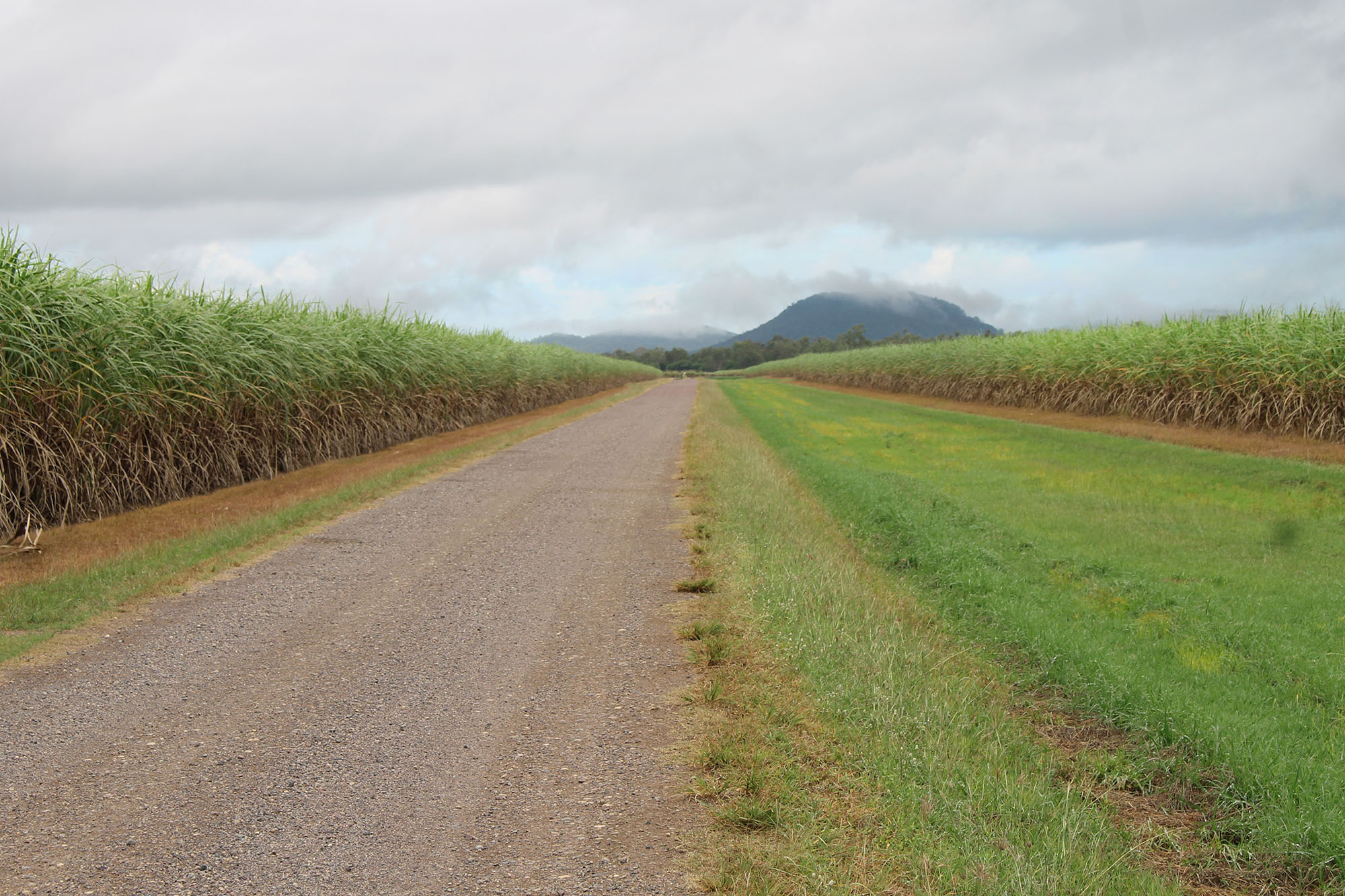
10 minute read
GROWER-DRIVEN HARVEST INNOVATION
Words and photos by Kirili Lamb
Reversing a haulout tractor straight as an arrow in the interrow is a practiced art in harvesting, and not something new haulout drivers can necessarily do.
Advertisement
A family of growers saw a solution, but it wasn’t until after many, many phone calls to tractor and tech firms that they finally connected with a small Brisbane start-up who said “We can do that!”. The solution achieved is showing a whole slew of benefits across harvest efficiency, safety, and crop and soil health.
It’s an industry problem – when a reversing tractor goes awry it can be a safety issue, it can compact rows, cause damage to machinery, and can result in lost time and cane.
As GPS and Real Time Kinematics moved into popular use, the Grech Family could see immediately a particular application.
Across three generations, the Grech men are all growers, harvest contractors, and qualified fitters and turners. They are solutions-oriented people.
“We started with a problem,” said Michael. “Getting drivers to reverse fill and stay beside the harvester - and off the stools.”
There was a need to bring auto-steer to the reversing process, to address problems such as driver training, risks to stools and machinery, the pitfalls of working with mirrors, or fatigue from constantly looking back over the shoulder.
Nathan said they had seen the efficiencies inherent in reverse filling in the past, when they had been using rubber tracks on tipper bins and tractors, reducing the need for lost time on change outs in wet conditions.
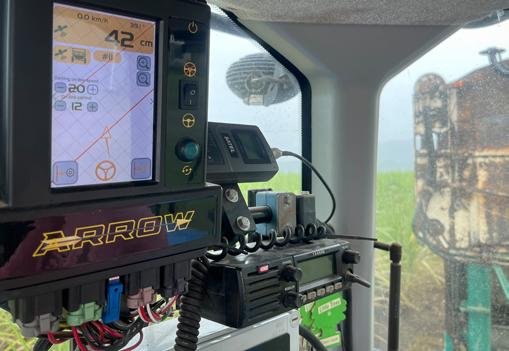
On-tractor ECU and interface.
“For the size of the machines, it was much easier to forward and reverse rather than turning around. We have gone from tracks to wheels since then, and we have still seen the efficiency of forward and reverse filling,” he said.
“Once you get used to it, stick it out, everyone preferred it, they could see the benefits from it,” Nathan said. “Given a choice between turning round at the ends of the rows or reversing, everybody would choose to reverse.”
Why does that efficiency gain matter?
“Mills want bigger harvesting groups, so you’ve got to pick up every second, as much time as possible. There is that area where you can pick up, not turning on the ends, where you are least productive," Chris explained.
"And that’s where the forward and reversing comes in. Initially, it was because we were on rubber tracks, but when Nathan went to the tri-axles, we still wanted to go with forward and reversing, to keep up efficiency.
“We were one of the first to go to full-time harvesting with a full track harvester, and look where it has gone. We have always tried to be leaders in the industry, from back in our days –Kevin, Michael and myself. And now Nathan has come along and brought in new changes also.”
Efficiency gains with reverse fill can be a swift as 15 seconds of elevator off-time at ends of rows, elevator engine hours being a core productivity measure.
Committed to the tech solution that they could see that would make this approach easier, Michael, who had recently retired from his work in the engineering sector, set about finding the reverse trailer autosteer technology they – and other contractors needed.
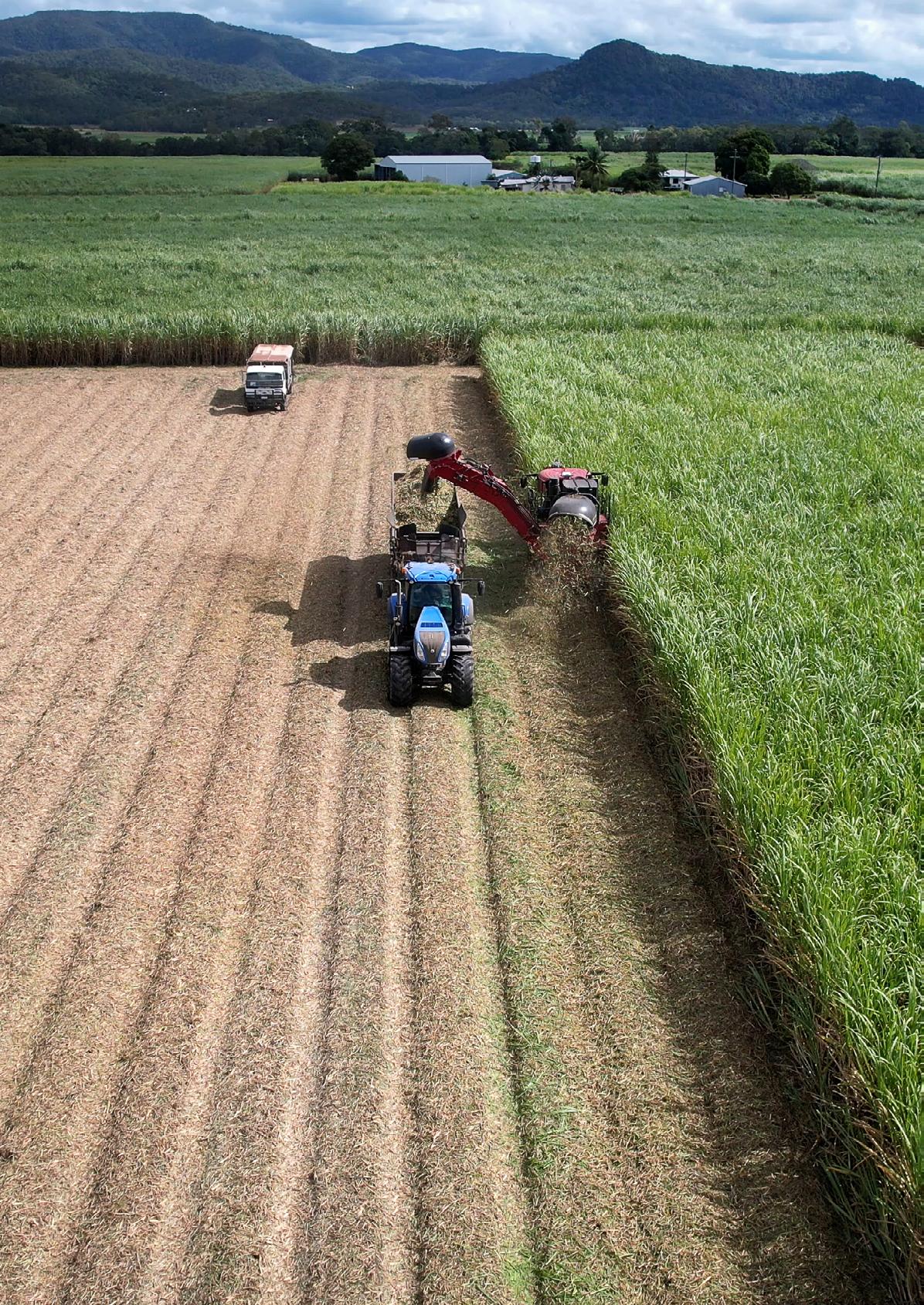
Reversing straight to a programmed positional line.
Photo: Clayton Grech
“I rang about 20 different tractor companies, asking what technology they had,” Michael said. “But I got told it was too hard. No-one had any ideas or solutions.
"People outside the industry don’t understand why we want to do it. No-one seemed interested.”
Two years later and still undeterred, Michael finally connected with a small Brisbane-based tech startup – 2Infinity Control Solutions. He spoke to them at the very end of 2021, and by the start of the 2022 crush, their tractors and trailers were fitted with an innovation on an existing autosteer control system.
2Infinity owner/principal engineer Neil Rutland is a UK-born engineer with a PhD in control systems and a background in military applications for guidance, navigation and control systems. When he turned his attention to agriculture in Australia, he connected with colleague, control applications engineer Brendan Joiner, at AgJunction in Brisbane.
They were colleagues for 8 years, before Neil established 2Infinity in 2017, joined by Brendan a year later. Brendan grew up on a dairy farm, and his earliest work was in cotton, with Beeline Technologies, a pioneer in tractor auto steer.

From left, Nathan and Michael Grech, Neil Rutland, Brendan Joiner and Chris Grech.
“Farming is in my blood, but I always loved the tech stuff and then I got to use that to assist farmers to improve productivity and efficiency through automated steering,” said Brendan. The company had already developed the “no bells and whistles” Arrow autosteer, a challenge they had set themselves when they established the company, after hearing farmers complain of overcomplicated control systems full of features they never use. The reversing trailer control (RTC) innovates on that initial autosteer.
“We were doing steering for tractors already when we were approached about steering a trailer in reverse, where you just steer the tractor and there is no steering in the trailer. That is the same simplicity as reversing a ute and trailer: it’s all in the front axles. We knew if people could do it, then we could automate it. We knew it would be a challenge, but we were confident we could do it,” said Neil.
Brendan elaborates: “So, the Arrow-RTC concept is quite simple - from the outside anyway - when travelling in forward direction ArrowRTC controls the position of the tractor, just as the standard Arrow or any other guidance system would do.

Brendan Joiner demonstrates Arrow RTC’s performance on the Grech farm.
“When it detects reverse travel direction it then controls the position of the trailer, still only using the tractor’s front axle steering. We use dual RTK receivers on both the tractor and trailer along with inertial sensors to get full position information into the controller.
“It took us about four months of development to add the trailer control to the existing Arrow system. By industry standards, that is rapid development. That is part of what makes us different, our small size and breadth of skills allow us to be agile developers. We also use in-house developed simulation and modelling tools that reduce the amount of field testing required.”
Paddocks are mapped with data stored and easily transferred via USB between tractors. The reverse camera extends capacity to comfortably watch the surrounds.
Brendan and Neil laugh as they show a picture of initial trialling of the system before they were ready to bring the components to Mackay for fitting. That initial field testing was done using Neil’s ride on mower (with auto steer fitted) and a modifiedto-scale ATV trailer simulating Nathan’s tractor and trailer combination.
The system was then ready to fit to tractors when they came to Mackay, within the deadline of a May harvest start.
“It worked from day dot. I couldn’t believe it when I got in the tractor,” said Nathan. “You set the A-B line and bang, straight on it.”
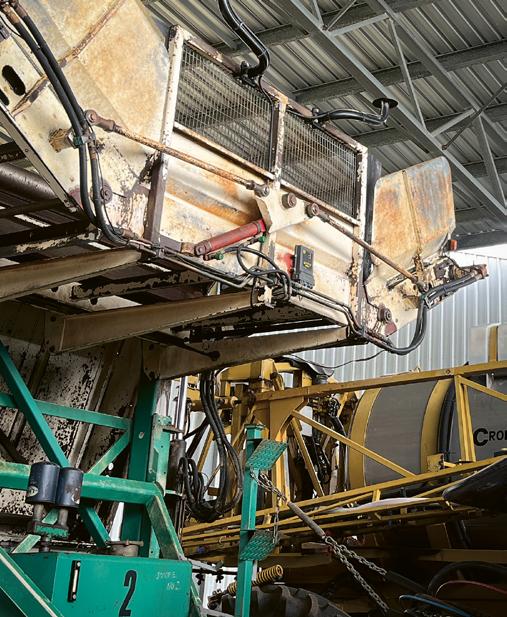
Trailer RTK GNSS arms and ECU sensor, which is paired to on-tractor RTK GNSS and ECU.
Operator fatigue has been a consideration. The Grechs are pleased to report great feedback from their haulout operator crew regarding the autosteer trailer reverse. Initial in-harvest trials involved two haulout drivers using the RTC, and one operating manually.
“At the end of a big day, we spoke to the two guys that had the GPS, and to the guy that had to reverse all day. And you could just see the difference in fatigue, a big difference,” said Chris.
Nathan noted that, because a lot of their workforce now were older workers and retirees, that was a critical factor aiding staff retention.
“You don’t want the older people getting tired. They are good- they turn up every day, they are reliable,” Nathan said.
Past vision issues, such as dusty dirty windows or glare when the sun is low (or gone for the day) are now eliminated.
One unexpected outcome turned out to be that labour retention. By creating a physically more comfortable, less fatiguing work situation, last year’s crew are all keen to work with the Grech’s harvest business OnTrack Harvesting again in 2023.
Similarly, it has made the haulout driver training process that much quicker.
Nathan noticed that they, as harvester operators, could relax a little also.
“You are always looking out for each other; you keep an eye out. They can be staying straight 99% of the day, but it only takes that one row where they drift off, and before you know it, they can be reversing into your pump box. As a harvester operator, for me, you are always alert, always watching. You go home at night fully wrecked,” said Nathan.
“You get to know who you have got beside you, and what you have to watch for. But last year, with the RTC, it was just so much easier, so much more relaxed. It saved my neck, I had to look at the elevator half the amount of times.”
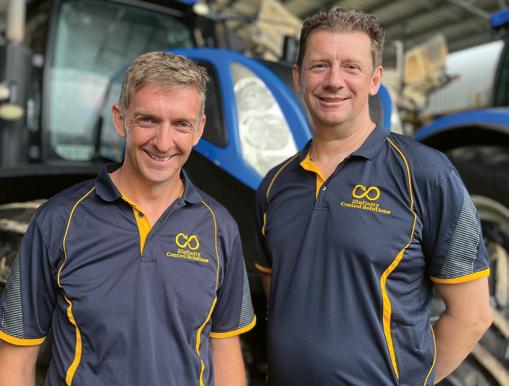
2Infinity Control Solutions team-senior Control Applications Engineer Brendan Joiner, left, with owner and Principal Engineer Neil Rutland.
He felt the biggest result for farmers was the reduction in compaction on the rows.
“We are only running on our controlled traffic areas,” he said. They said the tendency for drivers reversing by eye, using trash blanket tracks as a guide meant that if one followed a line of error, others would follow.
Precise to two centimetres with the tractor and to within four centimetres with the RTC, the marks seen in the trash blanket at the end of the day were only in the interrow.
“The track that has been laid is a dead straight line,” Chris said.
Nathan’s son Clayton, 16, is studying drone piloting at school, and his footage shows the high-precision performance working to an A-B line.
Not turning at the ends means reduced compaction at row ends also.
Having worked hard to achieve this solution, having had the vision and invested in that vision, the Grech’s can now say that they are both happy and relieved by the outcome, and are looking forward to another year’s harvesting with increased safety and efficiency.
“We’re more than happy coming out of the [2022] season knowing how they went,” Chris said.
Moreover, they can see this as technology with applications outside cane harvest where accurate or challenging reversing is essential.
“Brendan and Neil have started on this, but I reckon the system can be put onto a hell of a lot of other machinerytrucks and trailers,” Michael said. “It will have a lot of applications.”
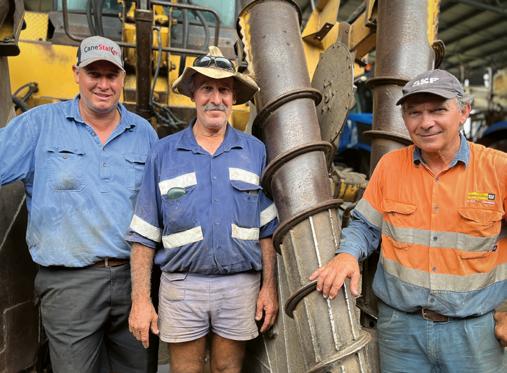
From left, Nathan, Chris and Michael Grech.
The Grech family has been farming cane for three generations, with the fourth coming through, now in their teens. The family farm is at Munbura, just south of Mackay. Brothers Chris and Michael are working the farm, while younger brother Kevin runs a second farm nearby.
Chris’ son Nathan is engaged with both the farm and the harvest contracting business with Chris. They have 270 hectare under cane across the two farms, and fallow with twice yearly cash crops of soy or mung bean. Their harvest group cut 89,000 tonne in 2022.










